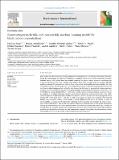Por favor, use este identificador para citar o enlazar a este item:
http://hdl.handle.net/10261/346140COMPARTIR / EXPORTAR:
 SHARE SHARE
 CORE
BASE CORE
BASE
|
|
| Visualizar otros formatos: MARC | Dublin Core | RDF | ORE | MODS | METS | DIDL | DATACITE | |

| Título: | Constructing transferable and interpretable machine learning models for black carbon concentrations |
Autor: | Fung, Pak Lun; Savadkoohi, Marjan CSIC ORCID; Zaidan, Martha Arbayani; Niemi, Jarkko V; Timonen, Hilkka; Pandolfi, Marco CSIC ORCID; Alastuey, Andrés CSIC ORCID ; Querol, Xavier CSIC ORCID ; Hussein, Tareq; Petäjä, Tuukka | Palabras clave: | Virtual sensors BC estimation Neural network Relative importance SHAP Traffic emission |
Fecha de publicación: | 22-ene-2024 | Editor: | Elsevier | Citación: | Environment International 184: 108449 (2024) | Resumen: | Black carbon (BC) has received increasing attention from researchers due to its adverse health effects. However, in-situ BC measurements are often not included as a regulated variable in air quality monitoring networks. Machine learning (ML) models have been studied extensively to serve as virtual sensors to complement the reference instruments. This study evaluates and compares three white-box (WB) and four black-box (BB) ML models to estimate BC concentrations, with the focus to show their transferability and interpretability. We train the models with the long-term air pollutant and weather measurements in Barcelona urban background site, and test them in other European urban and traffic sites. Despite the difference in geographical locations and measurement sites, BC correlates the strongest with particle number concentration of accumulation mode (PNacc, r = 0.73-0.85) and nitrogen dioxide (NO2, r = 0.68-0.85) and the weakest with meteorological parameters. Due to its similarity of correlation behaviour, the ML models trained in Barcelona performs prominently at the traffic site in Helsinki (R2 = 0.80-0.86; mean absolute error MAE = 3.90-4.73 %) and at the urban background site in Dresden (R2 = 0.79-0.84; MAE = 4.23-4.82 %). WB models appear to explain less variability of BC than BB models, long short-term memory (LSTM) model of which outperforms the rest of the models. In terms of interpretability, we adopt several methods for individual model to quantify and normalize the relative importance of each input feature. The overall static relative importance commonly used for WB models demonstrate varying results from the dynamic values utilized to show local contribution used for BB models. PNacc and NO2 on average have the strongest absolute static contribution; however, they simultaneously impact the estimation positively and negatively at different sites. This comprehensive analysis demonstrates that the possibility of these interpretable air pollutant ML models to be transfered across space and time. | Versión del editor: | https://doi.org/10.1016/j.envint.2024.108449 | URI: | http://hdl.handle.net/10261/346140 | DOI: | 10.1016/j.envint.2024.108449 | ISSN: | 01604120 |
| Aparece en las colecciones: | (IDAEA) Artículos |
Ficheros en este ítem:
| Fichero | Descripción | Tamaño | Formato | |
|---|---|---|---|---|
| 1-s2.0-S0160412024000357-main.pdf | Artículo principal | 7,16 MB | Adobe PDF |  Visualizar/Abrir |
| 1-s2.0-S0160412024000357-mmc1.docx | Material suplementario | 1,24 MB | Microsoft Word XML | Visualizar/Abrir |
CORE Recommender
Page view(s)
11
checked on 05-may-2024
Download(s)
3
checked on 05-may-2024
Google ScholarTM
Check
Altmetric
Altmetric
NOTA: Los ítems de Digital.CSIC están protegidos por copyright, con todos los derechos reservados, a menos que se indique lo contrario.


